- Home
- Peter Matthiessen
The Cloud Forest Page 9
The Cloud Forest Read online
Page 9
Sooner or later the traveler in South America may happen upon a revolution, and especially should he choose to spend much time in Bolivia, where the government is chronically so fractured and unstable that it can scarcely be called a government at all. An unpromising situation was made worse by the revolution and agricultural reforms of a few years ago, which, while commendable in principle, included the nationalization of the valuable tin and silver mines, and gutted the poor national economy by placing the country’s exploitation in the hands of amateurs. These amateurs disapprove of one another, not infrequently with good reason, and while I was in Bolivia the town of Santa Cruz de la Sierra and surrounding territories were physically controlled by the opposition party, in a state of open rebellion which, in any other land, would have to be described as civil war.
In La Paz on Saturday morning of March 19, about five a.m., I was awakened by a cascade of gunfire—rifle shots, then machine guns, and finally the dull boom of mortars. I was staying with friends, Dorry and Ted Blacque, whose handsome house overlooks the steep gorge of the Choqueyapu River and is situated on a line between Army Headquarters and the Defense Ministry; the house is still bullet-pocked from the last revolution, in 1952. I got up and went downstairs, where the maid was very nervous and upset. “Matan la gente, matan la gente,” she said to me, wringing her hands. “They are killing people.”
The firing continued, way off down the canyon, and two hours later the Bolivian Air Force, represented by two ancient United States Navy SN1 trainers, came droning past at a low altitude. A heavy boom, and the planes swept back down the gorge: apparently they had dropped some sort of explosive, presumably from the after cockpit. Apparently, too, someone had shot at them, for they did not repeat the maneuver; for the rest of the day they circled the city at prudent heights, just barely visible, while the radio ranted excitedly about aerial reconnaissance.
The radio had by now informed us that the glorious people’s revolution was being threatened by a dastardly counter-revolution led by the carabineri, or military police; clearly these wretches were in cahoots with the plotters in Santa Cruz. The counter-revolutionaries were trying to gain control of the plateau rim surrounding the capital. Already one side or the other had hurled a mortar into the home of the innocent family Cuba, wiping it out, and the toll of dead and wounded was mounting rapidly. The chief of the carabineri had been sentenced to death, ten thousand armed campesinos constituting the civil guard had been called in from the countryside to assist the patriotic soldiers of the Army, and a national emergency had been declared.
There was a steady whackety-whack and dum-dum-dum of fire—81-millimeter mortars and .50-caliber machine guns erupting among the rifle shots. By mid-morning the fighting was confined to the heights across the gorge. I had ventured out with binoculars and camera and was able to see, from a very safe distance, the explosions of mortar shells and the lines of scurrying men. It was impossible to determine which group was fighting which, or whether the thing had not become a free-for-all. The wide sunny streets of the city were empty of everything but suspense, though a few uneasy people stood in doorways. Here and there on corners stood groups of soldiers or some defected carabineri—these were rather self-conscious and tried to look as peace-loving as possible—or some irregulars of the civil guard, with armbands and ancient rifles. I talked with a group of the latter, who were excited and a little drunk, and who told me that the fighting was very close. This was untrue, however.
Farther up the hill a crowd had gathered outside a small hospital, where a casualty list had been posted; in this part of the city, so far, there were one dead and twenty-three wounded, a happy evidence of wretched marksmanship, since the blasting had been considerable. The atmosphere at the hospital was serious, but elsewhere the people, emerging in increasing numbers, only shook their heads, and many grinned; the civil guard, especially, was enjoying itself, for, as the radio reported later, “the noble women of our city rushed to provide their men with food and wine and cigarettes.” To judge from appearances, the greatest of these was wine. A squad of soldiers which came hurrying by, carrying mortars and radio-telephones, was very anxious that I take its picture and obligingly struck martial poses when I did so. But one elderly Bolivian who borrowed my binoculars was ashamed. “Muy feo,” he kept repeating, “muy feo—very ugly.” Then he mourned, “Now a country like Argentina, countries like that, it is only once every twenty years or so, but here—why, it is practically every other year.”
On the way back to the house I ran into a truckload of campesinos, Indians mostly, which an array of noble women had plied with chicha. A great deal of the damage on these occasions is done by drunken peasant boys who do not know how to use their rifles, and the city is invariably faced, after each revolution, with the problem of getting all these armed men out of town.
By noon the firing had substantially subsided; from the edge of the gorge I could see a file of men, carabineri, marching down the ridge opposite, waving a white flag. But the noon lull must have signified only lunch and the siesta, for around two the firing started up again. Directly across from the house where I was staying, a squad of soldiers scurried up the stairs of a skeletal new building without walls, and threw themselves on their stomachs at the corners of the roof. Their attackers did not materialize, however, and a little later they trooped down.
After this the firing dwindled to a halt, though there came an occasional round throughout the evening. Another short burst occurred the following morning, and I supposed that this was an execution. By five that afternoon the radio had announced that the people’s government controlled “perfectamente la situación” but was still uncertain whether or not a state of siege would be maintained throughout the city. We drove out later, in hopes that a Russo-Hungarian ballet scheduled for that evening would still go on, but the theater was dark and cold, and the bare, bright streets a little ominous; only a few campesinos, very drunk, loitered forlornly on the corners, looking belligerent and confused. Like the rest of us, they seemed uncertain what the whole thing had been about. There was even some talk that the counter-revolution had been staged by the government to consolidate its factions at the small price of a few Indian dead.
The next day the city was calm again, and I flew out across the western cordilleras to the coast and north to Lima.
In southwestern Bolivia and the northern extremities of Argentina and Chile the Andes reach their widest point, and the character of the altiplano is quite different from that to be seen farther north. This land is not only bleak but quite surreal, a dusty brown waste littered with curious heaps and windrows of rocks, raked up neatly by some giant hand. Dark, erratic weather increased its doom-ridden aspect, with small swift rains and looming cumulus and beyond, as the plane moved southeastward toward Buenos Aires, blue-black caverns of thunder between thick cirrus and the stony land. The light effects played ominously on these windy wastes of high sierra, made all the more desolate by what looked like dry riverbeds of another age and by a mute human habitation, scarcely discernible, and separated from visible roads or water by league upon league of savage ridges, cliffs, and canyons. To the rare traveler on the ground, this must be among the most awesome landscapes in the world.
The plane, sorely buffeted, struggled up over the last cordillera. It descended rapidly to the eastern slopes, where snaky brown streams glinted through a still, unearthly mist at the edge of a climbing forest. The streams joined the complex patterns of the larger rivers in the foothills, and then, where the Bermejo River coils outward into the flat jungle of northwest Argentina, the hills disappeared entirely. This region of low forest and arid scrub, all but uninhabited, is called the Gran Chaco; it extends far to the northward, across most of Paraguay and a large part of eastern Bolivia. The plane crosses several hundred miles of it before the scrub gives way to a vast treeless plain—the Pampa. On this part of the Pampa there are few houses, but the network of civilization may be seen in long dirt roads.
The pl
ane is high, and at seven in the evening the sun is still bright on the cloud crests of the horizon. For the people below, sundown is past, and the land lies shrouded in shadow. Just north of Santa Fe the maze of islands, marshes, creeks, and sloughs which fill the shallows of the River Paraná slide beneath the plane. Like so many of the variegated wildernesses of South America, this alluvial wasteland is enormous: the main stream of the river is all but lost somewhere in the middle of it. At the mouth of the river lies the great estuary known inappropriately as the River Plate.
South of the Gran Chaco, through Patagonia and Tierra del Fuego, the eastern slope of the Andes is barren, while its western slope, in the long southern reaches of Chile, is relatively wet and fertile; this, of course, is the exact reverse of the situation farther north.
Moving westward from Buenos Aires to Santiago, the rich farming plains of Buenos Aires province, with their islands of trees, give way to a dry pampa, and the Pampa in its turn to arid lands which merge at last with low, wrinkled foothills, the Sierra Córdoba. The foothills here are token, a narrow fringe of red-sand and gravel buttes, of meager plateaus. Then the dark mountains rise, snow-covered. The snow on these peaks, which appears more copious than in Peru, seems out of place until one recalls that to the southward, on this continent, lie the cold countries. Also, the sierra finds its summit here: the Andes claim none of the world’s five highest peaks, but they can boast the majority of the world’s first twenty. To the north the white crowns seemed to drift among the clouds, airborne and fleeting: one is Tupungato, 21,484 feet high, and, farther off, a colossus which must be the Andes’ highest, Aconcagua. At nearly 23,000 feet, Aconcagua is only 4000 less than Everest, and the spectacle drives all quotidian odds and ends straight from the brain. Then the mountains plunge toward the Pacific, and the plane slips down the western slope into the dry, pretty valley of Santiago.
Seven hundred miles south of Santiago lies the town of Puerto Montt, on the Gulf of Corcovado; from this point onward there are neither roads nor rail, for the great archipelago which constitutes all of southern Chile except the steep mountain slopes begins at Chiloé Island on the Gulf and sails down to the Hermite Islands and Cape Horn.
In Chile, in clear weather, the Andes are constantly in sight and march along with anyone who cares to take the rápido from Santiago to land’s end. The train leaves the capital at seven in the morning and is scheduled to arrive at midnight—on January 30, 1960, it was only two hours late, a feat unusual in South America—but the journey is well worth the slight fatigue.
Below Santiago the desert gives way almost immediately to the rich land of the central valley, green bottom land and vegetable farms, succeeded by pasture land and pine barrens—though in fact there is no clean line of demarcation between these areas, which are interspersed. Small clear streams with gravel sandbars slip across the valley from the mountains, cut deep as trenches into the land. In the face of Chile’s poverty, these good lands seem sparsely inhabited, scarcely exploited, though they are far from boundless.
To the eastward, as the day goes on, the cordillera diminishes in stature; it will sink into the sea at last at Staten Land, off the eastern end of Tierra del Fuego. Nevertheless, the snow increases, and as the highest mountains of this region are apt to be volcanoes, one sees a long, low range posted periodically with white-capped cones, including Villarica, Lanín, and finally Osorno, on the far side of Lake Llanquihue from Puerto Varas; I spent a few days in this town, which lies just north of Puerto Montt. It was long past dark when I arrived there, and I did not see Osorno until the following morning.
The Chilean mountain-lake country, in aspect anything but violent, was torn apart a few months after my departure by one of history’s most dreadful earthquakes. It is said to resemble Switzerland, and to a certain extent it does. It is rolling dairy land set among blue lakes and snowy peaks; the pastures are firmly fenced, the cattle tame and fat, and the Germans plentiful. But the mountains are more distant and less lofty than in Switzerland, and the atmosphere therefore more open, less pinched-in. And then there is the sense of the vast ocean a few scant miles to the westward. It is hot and clear in the summer days, and cold at night.
I passed most of my time in the woods and pastures above the town. In one plowed field a conclave of odd birds had gathered—forty or more brown raffish hawks of the vulturish caracara family, here called chimangos, and the turkey vulture or gallinazo, and numerous loud lapwings, strikingly marked, and the black-faced ibis, short-legged and fawn-colored on the neck, with its hollow, gloomy call. The common songbirds were the Chilean song sparrow, rusty-collared, and the tit-like tyrant, a dingy little bird with a bedraggled head plume which acts more like a warbler than like the flycatcher it is. There was also a sort of dusky robin with a voice quite like that of its relative in North America.
The trees, like the birds, were unfamiliar, and a number of the field flowers were quite strange, as were some lovely varieties in the woods; at the edge of the woods I saw a small thick brown snake but did not detain it. Beyond the woods lay more pastures, broken by the cheerful black-and-white of cows, and then the cold blue lake and the volcano; this much was Chile. But when I lay down in the warm pasture grass I felt a surge of homesickness: the grains and wild grasses, the purple clover and yellow dandelions, the thistles, yellow-jacket bees, the saw of grasshoppers, the green aphids, the robin song and tink of sparrows, a distant bird which sounded like a yellowthroat, and a sparrow hawk hovering above a grass clump on the far side of a sunny, wet, redolent meadow—I had to look across the lake to the volcano, with its Chinese hat of snow, to remind myself that I was four months and five thousand miles or more from some high New England pasture in the early days of May.
4
Tierra del Fuego
THE SOUTHERLY LIMITS of ordinary travel in South America are the towns of Bariloche, in the Argentine foothills of Andean Patagonia, and its Chilean counterpart, Puerto Montt, which lies at the head of the Corcovado Gulf and the Chilean Archipelago; these not-far-distant towns are linked in a rather spectacular tourist route through the lovely mountain lakes of both countries, with good connections to Santiago and Buenos Aires. Land’s end, on the other hand, is more than one thousand miles to the south, in the Hermite Islands—the wild sea rock called Cape Horn. To proceed farther than Puerto Montt, one should probably have a better reason than my own, which is nothing more than a desire of long standing to lay eyes on Patagonia, the Strait of Magellan, and Tierra del Fuego.
Heading southward down the Gulf of Corcovado, the plane from Puerto Montt to Punta Arenas, on the Straits, crosses the first island of the archipelago. With its deep coves, pretty farms, and broad gray beaches, this island is quite unlike those at the southern end of this greatest of the world’s archipelagos. There are other, smaller islands, and, off to the westward, the Chiloé Channel and the Pacific. Though the day is clear, Chiloé Island, the largest of the group, rises and fades in its attendant clouds. To the east the Andes, slowly diminishing in stature as they move southward, are bright with snow; in the early light the lower slopes and the islands alongshore are a somber black beneath white wisps of cloud, while the islands to the west are brown and green. There are literally hundreds of islands to be seen, all but the smallest maintaining a few farms, but the sea around them is flat and empty, with only a few small sails of fishermen banded together on a distant shoreline.
Farther south the island forests are unbroken; there is scarcely a sign of human habitation. The islands vary from a few hundred yards to fifteen miles in length, and one of them is nothing more than a great flat-topped monolith of rock, jutting up out of the sea like the base of a fallen monument, with only the barest fringe of boulder shore below.
Now the plane heads inland, skirting the twisted peak of Corcovado, with its vertical columnar crest—“the lofty-peaked Corcovado,” Darwin called it, “well deserving the name of ‘el famoso Corcovado.’” Below, blue glaciers tum like diamonds in the sun, feeding cold emer
ald lakes shut away from the world by cliffs. A dense forest crawls up steep ravines and sunny flanks to tree line, and lonely rivers wind their way among cold bars of gravel, but the prevailing elements are sky and snow and granite. High among the peaks bright ponds of glacier water are inset; from these white streaks of foam rush off down the shadowy ravines, headwaters of a stream, perhaps a river, with no name. Farther south lakes of ice blue are pinned in by boreal forest, and an occasional lake, quite out of place here, the color of pea soup.
The Pacific is no longer visible. We cross an altiplano of barren alpine tundra, broken here and there by a few shrub-bordered streams, a thin patch of forest, and curious terraces and hillocks. The wind howls over this brown world, and by the time the buttes rise up around a mountain village the two-engine plane is bounding like a kite, with dreadful uproar and vibration. We are now trapped in a sort of gorge, with a mountain river on the south side, and after a brief and extremely unpleasant interlude of jolts and plunges, touch down on a narrow terrace between butte and gorge—Caihaique.
Mountain flying is, for me, the worst aspect of an uneasy means of travel, though on rare mountain days without wind and downdrafts it can be both exhilarating and intensely beautiful. Today there is a distinct malaise among the passengers; we push out through the cabin door like frightened sheep, and it is nearly an hour before we can be herded in again. Had the plane not been the only means of departure from Caihaique, I suspect it would have left a number of its passengers right there.
I have come to regard myself, without any real justification, as a connoisseur of bad moments in the air, and it is my heartfelt opinion that the take-off was worse than the landing. Not only did we barely clear the end of the rude runway but, confronted with the oncoming Andes, the pilot was forced to bank so sharply in the wind that the right wing, for one terrible moment, seemed caught irretrievably at a near-vertical angle: one gust, it seemed, and the plane would be flipped on its back like a turtle. The pilot may have been shaken too, because for the next hour or more the piloting of our fragile craft seemed to me to lack authority. We rose and fell, turned in half-circles, speeded up in sudden bursts to clear unseen obstacles ahead, and in general careened around among the mountains in a decidedly haphazard manner.

 Lost Man's River: Shadow Country Trilogy
Lost Man's River: Shadow Country Trilogy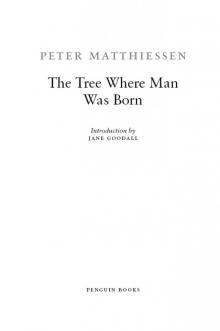 The Tree Where Man Was Born
The Tree Where Man Was Born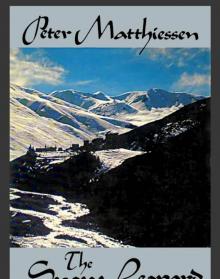 The Snow leopard
The Snow leopard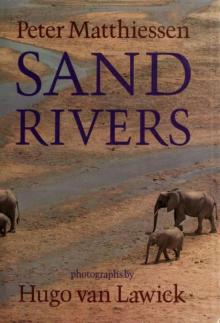 Sand Rivers
Sand Rivers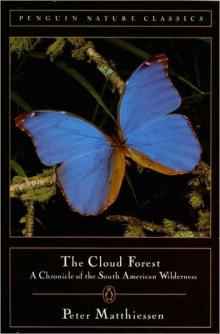 The Cloud Forest
The Cloud Forest Sal Si Puedes (Escape if You Can)
Sal Si Puedes (Escape if You Can) Far Tortuga
Far Tortuga Men's Lives
Men's Lives On the River Styx: And Other Stories
On the River Styx: And Other Stories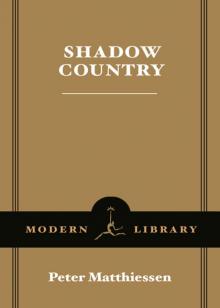 Shadow Country
Shadow Country At Play in the Fields of the Lord
At Play in the Fields of the Lord Lost Man's River
Lost Man's River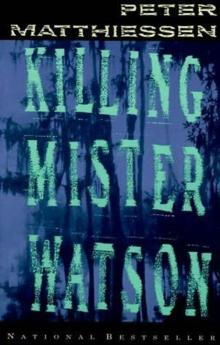 Killing Mister Watson
Killing Mister Watson On the River Styx
On the River Styx